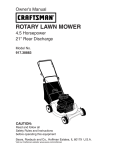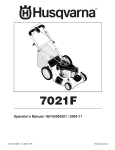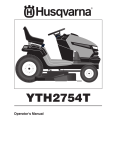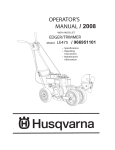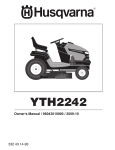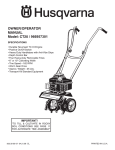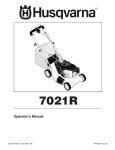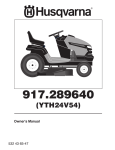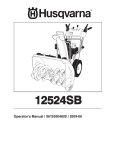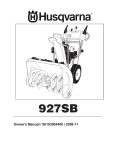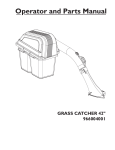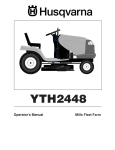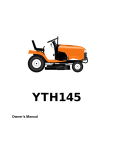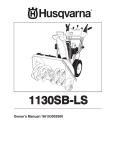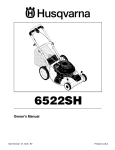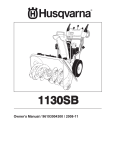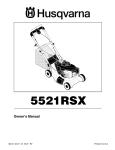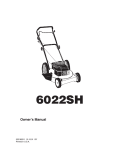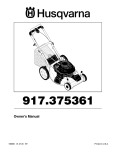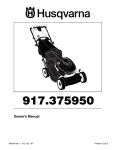Download Husqvarna XT722FE User's Manual
Transcript
XT722FE Owner’s Manual / 96143005800/ 2009-10 532 43 14-45 10.16.09 BY Printed in U.S.A. SAFETY RULES Safe Operation Practices for Walk-Behind Mowers IMPORTANT: THIS CUTTING MACHINE IS CAPABLE OF AMPUTATING HANDS AND FEET AND THROWING OBJECTS. FAILURE TO OBSERVE THE FOLLOWING SAFETY INSTRUCTIONS COULD RESULT IN SERIOUS INJURY OR DEATH. • Look for this symbol to point out important safety precautions. It means CAUTION!!! BECOME ALERT!!! YOUR SAFETY IS INVOLVED. • • CAUTION: Always disconnect spark plug wire and place wire where it cannot contact spark plug in order to prevent accidental starting when setting up, transporting, adjusting or making repairs. • • WARNING: Engine exhaust, some of its constituents, and certain vehicle components contain or emit chemicals known to the State of California to cause cancer and birth defects or other reproductive harm. • • • • WARNING: Battery posts, terminals and related accessories contain lead and lead compounds, chemicals known to the State of California to cause cancer and birth defects or other reproductive harm. Wash hands after handling. II. SLOPE OPERATION Slopes are a major factor related to slip and fall accidents which can result in severe injury. All slopes require extra caution. If you feel uneasy on a slope, do not mow it. DO: • Mow across the face of slopes: never up and down. Exercise extreme caution when changing direction on slopes. • Remove obstacles such as rocks, tree limbs, etc. • Watch for holes, ruts, or bumps. Tall grass can hide obstacles. DO NOT: • Do not trim near drop-offs, ditches or embankments. The operator could lose footing or balance. • Do not trim excessively steep slopes. • Do not mow on wet grass. Reduced footing could cause slipping. CAUTION: Muffler and other engine parts become extremely hot during operation and remain hot after engine has stopped. To avoid severe burns on contact, stay away from these areas. I. GENERAL OPERATION • • • • • • • • • • Read, understand, and follow all instructions on the machine and in the manual(s) before starting. Be thoroughly familiar with the controls and the proper use of the machine before starting. Do not put hands or feet near or under rotating parts. Keep clear of the discharge opening at all times. Only allow responsible individuals, who are familiar with the instructions, to operate the machine. Clear the area of objects such as rocks, toys, wire, bones, sticks, etc., which could be picked up and thrown by the blade. Be sure the area is clear of other people before mowing. Stop machine if anyone enters the area. Do not operate the mower when barefoot or wearing open sandals. Always wear substantial foot wear. Do not pull mower backwards unless absolutely necessary. Always look down and behind before and while moving backwards. Never direct discharged material toward anyone. Avoid discharging material against a wall or obstruction. Material may richochet back toward the operator. Stop the blade when crossing gravel surfaces. Do not operate the mower without proper guards, plates, grass catcher or other safety protective devices in place. See manufacturer’s instructions for proper operation and installation of accessories. Only use accessories approved by the manufacturer. Stop the blade(s) when crossing gravel drives, walks, or roads. Stop the engine (motor) whenever you leave the equipment, before cleaning the mower or unclogging the chute. Shut the engine (motor) off and wait until the blade comes to complete stop before removing grass catcher. Mow only in daylight or good artificial light. Do not operate the machine while under the influence of alcohol or drugs. Never operate machine in wet grass. Always be sure of your footing: keep a firm hold on the handle and walk; never run. Disengage the self-propelled mechanism or drive clutch on mowers so equipped before starting the engine (motor). If the equipment should start to vibrate abnormally, stop the engine (motor) and check immediately for the cause. Vibration is generally a warning of trouble. Always wear safety goggles or safety glasses with side shields when operating mower. III. CHILDREN Tragic accidents can occur if the operator is not alert to the presence of children. Children are often attracted to the machine and the mowing activity. Never assume that children will remain where you last saw them. • Keep children out of the trimming area and under the watchful care of another responsible adult. • Be alert and turn machine off if children enter the area. • Before and while walking backwards, look behind and down for small children. • Never allow children to operate the machine. • Use extra care when approaching blind corners, shrubs, trees, or other objects that may obscure vision. IV. SAFE HANDLING OF GASOLINE 2 Use extreme care in handling gasoline. Gasoline is extremely flammable and the vapors are explosive. • Extinguish all cigarettes, cigars, pipes and other sources of ignition. • Use only an approved container. • Never remove gas cap or add fuel with the engine running. Allow engine to cool before refueling. • • • • • • • Never refuel the machine indoors. Never store the machine or fuel container where there is an open flame, spark or pilot light such as a water heater or on other appliances. Never fill containers inside a vehicle, on a truck or trailer bed with a plastic liner. Always place containers on the ground away from your vehicle before filling. Remove gas-powered equipment from the truck or trailer and refuel it on the ground. If this is not possible, then refuel such equipment with a portable container, rather than from a gasoline dispenser nozzle. Keep the nozzle in contact with the rim of the fuel tank or container opening at all times until fueling is complete. Do not use a nozzle lock-open device. If fuel is spilled on clothing, change clothing immediately. Never overfill fuel tank. Replace gas cap and tighten securely. • • • • • • • V. GENERAL SERVICE • • • Never run a machine inside a closed area. Never make adjustments or repairs with the engine (motor) running. Disconnect spark plug wire, and keep • wire away from plug to prevent accidental starting. Keep nuts and bolts, especially blade attachement bolts, tight and keep equipment in good condition. Never tamper with safety devices. Check their proper operation regularly. Keep machine free of grass, leaves, or other debris build-up. Clean oil or fuel spillage. Allow machine to cool before storing. Stop and inspect the equipment if you strike an object. Repair, if necessary, before restarting. Never attempt to make wheel height adjustments while the engine (motor) is running. Grass catcher components are subject to wear, damage, and deterioration, which could expose moving parts or allow objects to be thrown. Frequently check components and replace with manufacturer’s recommended parts, when necessary. Mower blade is sharp and can cut. Wrap the blade or wear gloves, and use extra caution when servicing it. Do not change the engine governor setting or overspeed the engine. Maintain or replace safety and instruction labels, as necessary. WARNING: This lawn mower is equipped with an internal combustion engine and should not be used on or near any unimproved forest-covered, brush-covered or grass-covered land unless the engine’s exhaust system is equipped with a spark arrester meeting applicable local or state laws (if any). If a spark arrester is used, it should be maintained in effective working order by the operator. A spark arrester for the muffler is available through your nearest authorized service centre. CONGRATULATIONS on your purchase of a new lawn mower. It has been designed, engineered and manufactured to give you the best possible dependability and performance. Should you experience any problem you cannot easily remedy, please contact your nearest authorized service center/department. We have competent, well-trained technicians and the proper tools to service or repair this lawn mower. Please read and retain this manual. The instructions will enable you to assemble and maintain your lawn mower properly. Always observe the “SAFETY RULES”. PRODUCT SPECIFICATIONS SERIAL NUMBER: _________________________________ Gasoline Capacity and Type: 1.5 Quarts (Unleaded Regular Only) Oil Type (API SG–SL): SAE 30 (above 32°F); SAE 10W-30 (below 32°F) Oil Capacity: 20 Ounces Spark Plug (Gap: .030"): Champion RC12YC Blade Bolt Torque: 35-40 ft. lbs. CUSTOMER RESPONSIBILITIES DATE OF PURCHASE: _______________________ • • THE MODEL AND SERIAL NUMBERS WILL BE FOUND ON A DECAL ATTACHED TO THE REAR OF THE LAWN MOWER HOUSING. • YOU SHOULD RECORD BOTH SERIAL NUMBER AND DATE OF PURCHASE AND KEEP IN A SAFE PLACE FOR FUTURE REFERENCE. Read and observe the safety rules. Follow a regular schedule in maintaining, caring for and using your lawn mower. Follow the instructions under “Maintenance” and “Storage” sections of this operator’s manual. TABLE OF CONTENTS SAFETY RULES ........................................................ 2-3 PRODUCT SPECIFICATIONS ..................................... 3 CUSTOMER RESPONSIBILITIES ............................... 3 ASSEMBLY ................................................................... 4 OPERATION .............................................................. 5-8 MAINTENANCE SCHEDULE ....................................... 9 MAINTENANCE ...................................................... 9-12 SERVICE AND ADJUSTMENTS ........................... 12-13 STORAGE ............................................................. 13-14 TROUBLESHOOTING ................................................ 15 WARRANTY................................................................ 20 3 ASSEMBLY Read these instructions and this manual in its entirety before you attempt to assemble or operate your new lawn mower. IMPORTANT: THIS LAWN MOWER IS SHIPPED WITHOUT OIL OR GASOLINE IN THE ENGINE. Your new lawn mower has been assembled at the factory with the exception of those parts left unassembled for shipping purposes. All parts such as nuts, washers, bolts, etc., necessary to complete the assembly have been placed in the parts bag. To ensure safe and proper operation of your lawn mower, all parts and hardware you assemble must be tightened securely. Use the correct tools as necessary to ensure proper tightness. TO REMOVE LAWN MOWER FROM CARTON FRAME HANDLE 1. Remove loose parts included with mower. 2. Cut down two end corners of carton and lay end panel down flat. 3. Remove all packing materials except padding between upper and lower handle and padding holding operator presence control bar to upper handle. 4. Roll lawn mower out of carton and check carton thorougly for additional loose parts. HOW TO SET UP YOUR LAWN MOWER TO UNFOLD HANDLE (See Fig. 1) IMPORTANT: UNFOLD HANDLE CAREFULLY SO AS NOT TO PINCH OR DAMAGE CONTROL CABLES. 1. Raise handles until lower handle section locks into place in mowing position. 2. Remove protective padding, raise upper handle section into place on lower handle and tighten both handle knobs. 3. Remove handle padding holding operator presence control bar to upper handle. Your handles may be adjusted for your mowing comfort. Refer to “ADJUST HANDLE” in the Service and Adjustments section of this manual. OPERATOR PRESENCE CONTROL BAR FIG. 2 TO INSTALL ATTACHMENTS Your lawn mower was shipped ready to be used as a mulcher. To convert mower to bagging or discharging, see “TO CONVERT MOWER” in the Operation section of this manual. TO PREPARE BATTERY (See Fig. 3) NOTE: Your battery must be charged before you can start your lawn mower. 1. Connect battery charger connector (male) to harness connector (female). 2. Plug battery charger into 110 volt A.C. outlet. 3. Leave battery charger connected for 24 hours before starting your engine for the first time. 4. After charging, disconnect harness connector (female) from battery charger connector (male). Connect your battery charger to charge battery as required. MOWING POSITION LIFT UP LIFT UP FRAME OPENING VINYL BINDINGS IMPORTANT: THE ENGINE WILL NOT RECHARGE YOUR BATTERY. AT THE END OF THE MOWING SEASON THE BATTERY SHOULD BE CHARGED FOR 48 HOURS TO PROTECT THE BATTERY DURING WINTER STORAGE. UPPER HANDLE CAUTION: Always disconnect the engine connector (male) from the battery connector (female) to prevent accidental starting when transporting or storing your lawn mower after the season. HANDLE KNOB LOWER HANDLE BATTERY BOX FIG. 1 ENGINE CONNECTOR (MALE) HARNESS CONNECTOR (FEMALE) TO ASSEMBLE GRASS CATCHER (See Fig. 2) 1. Put grass catcher frame into grass bag with rigid part of bag on the bottom. Make sure the frame handle is outside of the bag top. 2. Slip vinyl bindings over frame. NOTE: If vinyl bindings are too stiff, hold them in warm water for a few minutes. If bag gets wet, let it dry before using. BATTERY CHARGER 4 CHARGER CONNECTOR (MALE) FIG. 3 OPERATION KNOW YOUR LAWN MOWER READ THIS OWNER'S MANUAL AND SAFETY RULES BEFORE OPERATING YOUR LAWN MOWER. Compare the illustrations with your lawn mower to familiarize yourself with the location of various controls and adjustments. Save this manual for future reference. These symbols may appear on your lawn mower or in literature supplied with the product. Learn and understand their meaning. DRIVE CONTROL BAR OPERATOR PRESENCE CONTROL BAR KEY START SWITCH HANDLE KNOB AUXILIARY STARTER HANDLE GASOLINE FILLER CAP GRASS CATCHER AIR FILTER DRIVE COVER WHEEL ADJUSTER (ON EACH WHEEL) ENGINE OIL CAP WITH DIPSTICK MUFFLER HOUSING MULCHER DOOR IMPORTANT: This lawn mower is shipped WITHOUT OIL OR GASOLINE in the engine. SPARK PLUG MEETS CPSC SAFETY REQUIREMENTS Our rotary walk-behind power lawn mowers conform to the safety standards of the American National Standards Institute and the U.S. Consumer Product Safety Commission. The blade turns when the engine is running. KEY START SWITCH – used for starting the engine. AUXILIARY STARTER HANDLE – used for starting the engine. MULCHER DOOR – allows conversion to discharge or bagging operation. OPERATOR PRESENCE CONTROL BAR – must be held down to the handle to start the engine. Release to stop the engine. DRIVE CONTROL BAR – used to engage power-propelled forward motion of lawn mower. 5 OPERATION The operation of any lawn mower can result in foreign objects thrown into the eyes, which can result in severe eye damage. Always wear safety glasses or eye shields while operating your lawn mower or performing any adjustments or repairs. We recommend standard safety glasses or a wide vision safety mask over spectacles. HOW TO USE YOUR LAWN MOWER DRIVE CONTROL ADJUSTMENT (See Fig. 4) ENGINE SPEED Over time, the drive control system may become “loose”, resulting in decreased speed. There are holes in the drive control housing to increase tension on the drive cable. Proceed as follows: 1. Turn unit off and disconnect spark plug wire from spark plug. 2. Loosen nut, move drive control housing down handle to the next hole and retighten nut. 3. Operate mower to test drive speed. 4. If condition fails to improve after the above steps (forward speed remains the same), your drive belt is worn and should be replaced. The engine speed was set at the factory for optimum performance. Speed is not adjustable. ENGINE ZONE CONTROL CAUTION: Federal regulations require an engine control to be installed on this lawn mower in order to minimize the risk of blade contact injury. Do not under any circumstances attempt to defeat the function of the operator control. The blade turns when the engine is running. • Your lawn mower is equipped with an operator presence control bar which requires the operator to be positioned behind the mower handle to start and operate the mower. TO ADJUST CUTTING HEIGHT (See Fig. 5) Raise wheels for low cut and lower wheels for high cut, adjust cutting height to suit your requirements. Medium position is best for most lawns. • To change cutting height, squeeze adjuster lever toward wheel. Move wheel up or down to suit your requirements. Be sure all wheels are in the same setting. NOTE: Adjuster is properly positioned when plate tab inserts into hole in lever. Also, 9-position adjusters (if so equipped) allow lever to be positioned between the plate tabs. TO OPERATE DRIVE SYSTEM (See Fig. 4) • Self-propelling is controlled by holding the operator presence control bar down to the handle and pulling the drive control bar up to the handle. The closer to the handle the bar is pulled, the faster the unit will travel. • Forward motion will stop when either the operator presence control bar or drive control bar are released. To stop forward motion without stopping engine, release the drive control bar only. Hold operator presence control bar down against handle to continue mowing without self-propelling. NOTE: If after releasing the drive control the mower will not roll backwards, push the mower forward slightly to disengage drive wheels. • To keep drive control engaged when turning corners, push down on the handle to lift the front wheels off the ground while turning lawn mower. LEVER BACKWARD TO LOWER MOWER PLATE TAB LEVER FORWARD TO RAISE MOWER LEVER FIG. 5 TO ENGAGE DRIVE CONTROL OPERATOR PRESENCE CONTROL BAR TO CONVERT MOWER Your lawn mower was shipped ready to be used as a mulcher. To convert to bagging or discharging: DRIVE CONTROL DISENGAGED REAR BAGGING (See Fig. 6) • Open rear door and remove mulcher plug. Store mulcher plug in a safe place. • You can now install the grass catcher or optional clipping deflector. • To convert to mulching or discharging operation, install mulcher plug into rear discharge opening of mower. TO ADJUST, MOVE DOWN TO NEXT HOLE FIG. 4 6 OPERATION SIMPLE STEPS TO REMEMBER WHEN CONVERTING YOUR LAWN MOWER: FOR MULCHING 1. Mulcher plug installed. 2. Mulcher door closed. FOR REAR BAGGING 1. Mulcher plug removed. 2. Grass catcher installed. 3. Mulcher door closed. FOR SIDE DISCHARGING 1. Mulcher plug installed. 2. Discharge deflector installed. MULCHER PLUG FIG. 6 SIDE DISCHARGING (See Fig. 7) • Mulcher plug must be installed into rear discharge opening of mower. • Open mulcher door and install discharge deflector under door as shown. • Mower is now ready for discharging operation. • To convert to mulching or bagging operation, discharge deflector must be removed and mulcher door closed. CAUTION: Do not run your lawn mower without mulcher plug or approved grass catcher in place. Never attempt to operate the lawn mower with the rear door removed or propped open. TO EMPTY GRASS CATCHER (See Fig. 8) 1. Lift up on grass catcher using the frame handle. 2. Remove grass catcher with clippings from under lawn mower handle. 3. Empty clippings from bag. NOTE: Do not drag the bag when emptying; it will cause unnecessary wear. FRAME HANDLE OPEN MULCHER DOOR DISCHARGE DEFLECTOR FIG. 8 BEFORE STARTING ENGINE ADD OIL (See Fig. 9) Your lawnmower is shipped without oil in the engine. For type and grade of oil to use, see “ENGINE” in the Maintenance section of this manual. CAUTION: DO NOT overfill engine with oil, or it will smoke on startup. FIG. 7 7 1. Be sure lawnmower is level. 2. Remove oil dipstick from oil fill spout. 3. Engine holds 20 ounces of oil. For type and grade of oil to use, see “ENGINE” in the Maintenance section of this manual. OPERATION MOWING TIPS GASOLINE FILLER CAP CAUTION: Do not use de-thatcher blade attachments on your mower. Such attachments are hazardous, will damage your mower and could void your warranty. • ENGINE OIL CAP • FIG. 9 4. Pour oil slowly. Do not overfill. Wait one minute to allow oil to settle. Insert and tighten dipstick, then remove it to check oil level. • • IMPORTANT: • • Check oil level before each use. Add oil if needed. Fill to full line on dipstick. Change the oil after every 25 hours of operation or each season. You may need to change the oil more often under dusty, dirty conditions. See “TO CHANGE ENGINE OIL” in the Maintenance section of this manual. • MULCHING MOWING TIPS IMPORTANT: FOR BEST PERFORMANCE, KEEP MOWER HOUSING FREE OF BUILT-UP GRASS AND TRASH. SEE “CLEANING” IN MAINTENANCE SECTION OF THIS MANUAL. ADD GASOLINE (See Fig. 9) • Fill fuel tank to bottom of tank filler neck. Do not overfill. Use fresh, clean, regular unleaded gasoline with a minimum of 87 octane. Do not mix oil with gasoline. Purchase fuel in quantities that can be used within 30 days to assure fuel freshness. • CAUTION: Wipe off any spilled oil or fuel. Do not store, spill or use gasoline near an open flame. Alcohol blended fuels (called gasohol or using ethanol or methanol) can attract moisture which leads to separation and formation of acids during storage. Acidic gas can damage the fuel system of an engine while in storage. To avoid engine problems, the fuel system should be emptied before storage of 30 days or longer. Empty the gas tank, start the engine and let it run until the fuel lines and carburetor are empty. Use fresh fuel next season. See Storage Instructions for additional information. Never use engine or carburetor cleaner products in the fuel tank or permanent damage may occur. • • The special mulching blade will recut the grass clippings many times and reduce them in size so that as they fall onto the lawn they will disperse into the grass and not be noticed. Also, the mulched grass will biodegrade quickly to provide nutrients for the lawn. Always mulch with your highest engine (blade) speed as this will provide the best recutting action of the blades. Avoid cutting your lawn when it is wet. Wet grass tends to form clumps and interferes with the mulching action. The best time to mow your lawn is the early afternoon. At this time the grass has dried, yet the newly cut area will not be exposed to direct sunlight. For best results, adjust the lawn mower cutting height so that the lawn mower cuts off only the top one-third of the grass blades (See Fig. 10). If the lawn is overgrown it will be necessary to raise the height of cut to reduce pushing effort and to keep from overloading the engine and leaving clumps of mulched grass. For extremely heavy mulching, reduce your width of cut by overlapping previously cut path and mow slowly. MAX 1/3 TO STOP ENGINE • Under certain conditions, such as very tall grass, it may be necessary to raise the height of cut to reduce pushing effort and to keep from overloading the engine and leaving clumps of grass clippings. It may also be necessary to reduce ground speed and/or run the lawn mower over the area a second time. For extremely heavy cutting, reduce the width of cut by overlapping previously cut path and mow slowly. For better grass bagging and most cutting conditions, the engine speed should be set in the fast position. Pores in cloth grass catchers can become filled with dirt and dust with use and catchers will collect less grass. To prevent this, regularly hose catcher off with water and let dry before using. Keep top of engine around starter clear and clean of grass clippings and chaff. This will help engine air flow and extend engine life. To stop engine, release operator presence control bar. TO START ENGINE NOTE: Due to protective coatings on the engine, a small amount of smoke may be present during the initial use of the product and should be considered normal. NOTE: Your engine is equipped with an automatic choke system. No priming or choking is required before starting. • To start engine, hold operator presence control bar down to the handle and pull starter handle quickly. Do not allow starter rope to snap back. • • 8 FIG. 10 Certain types of grass and grass conditions may require that an area be mulched a second time to completely hide the clippings. When doing a second cut, mow across (perpendicular) to the first cut path. Change your cutting pattern from week to week. Mow north–south one week, then change to east–west the next week. This helps prevent matting/graining of lawn. MAINTENANCE BEFORE EACH USE AFTER EACH USE EVERY 10 HOURS EVERY 25 HOURS OR SEASON EVERY 100 HOURS BEFORE STORAGE Check for Loose Fasteners Clean / Inspect Grass Catcher * Check Tires Check Drive Wheels *** Clean Lawn Mower **** Clean under Drive Cover *** Check Drive Belt / Pulleys *** Check / Sharpen / Replace Blade Lubrication Clean and Recharge Battery ** Check Engine Oil level Change Engine Oil Clean Air Filter Inspect Muffler Replace Spark Plug Replace Air Filter Paper Cartridge Empty fuel system or add Stabilizer * (if so equipped) ** Electric-Start mowers *** Power-Propelled mowers a scraper **** Use to clean under deck 1 - Change more often if operating under a heavy load or in high outdoor temperatures. 2 - Service more often if operating in dirty or dusty conditions. 3 - Replace blades more often when mowing in sandy soil. 4 - Charge 48 hours at end of season. 5 - And after each 5 hours of use. GENERAL RECOMMENDATIONS The warranty on this lawn mower does not cover items that have been subjected to operator abuse or negligence. To receive full value from the warranty, operator must maintain mower as instructed in this manual. Some adjustments will need to be made periodically to properly maintain your unit. At least once a season, check to see if you should make any of the adjustments described in the Service and Adjustments section of this manual. • At least once a year, replace the spark plug, clean or replace air filter element and check blade for wear. A new spark plug and clean/new air filter element assure proper air-fuel mixture and help your engine run better and last longer. • Follow the maintenance schedule in this manual. BEFORE EACH USE LUBRICATION CHART ➀ WHEEL ADJUSTER (ON EACH WHEEL) ➁ ENGINE OIL ➀ MULCHER DOOR HINGE PIN ➀ REAR DOOR HINGE 1. Check engine oil level. 2. Check for loose fasteners. LUBRICATION Keep unit well lubricated (See “LUBRICATION CHART”). IMPORTANT: DO NOT OIL OR GREASE PLASTIC WHEEL BEARINGS. VISCOUS LUBRICANTS WILL ATTRACT DUST AND DIRT THAT WILL SHORTEN THE LIFE OF THE SELFLUBRICATING BEARINGS. IF YOU FEEL THEY MUST BE LUBRICATED, USE ONLY A DRY, POWDERED GRAPHITE TYPE LUBRICANT SPARINGLY. ➀ HANDLE BRACKET MOUNTING PINS ➀ SPRAY LUBRICANT 9 ➁ SEE “ENGINE” IN MAINTENANCE SECTION MAINTENANCE LAWN MOWER 4. Install the blade bolt with the lock washer and hardened washer into blade adapter and crankshaft. 5. Use block of wood between blade and lawn mower housing and tighten the blade bolt, turning clockwise. • The recommended tightening torque is 35-40 ft. lbs. Always observe safety rules when performing maintenance. TIRES • • Keep tires free of gasoline, oil, or insect control chemicals which can harm rubber. Avoid stumps, stones, deep ruts, sharp objects and other hazards that may cause tire damage. IMPORTANT: BLADE BOLT IS HEAT TREATED. IF BOLT NEEDS REPLACING, REPLACE ONLY WITH APPROVED BOLT SHOWN IN THE REPAIR PARTS SECTION OF THIS MANUAL. DRIVE WHEELS BLADE ADAPTER Check front drive wheels each time before you mow to be sure they move freely. The wheels not turning freely means trash, grass cuttings, etc. are in the drive wheel area and must be cleaned to free drive wheels. If necessary to clean the drive wheels, be sure to clean both front wheels. 1. Remove hubcaps, locknuts and washers. 2. Remove wheels from wheel adjusters. 3. Remove any trash or grass cuttings from inside the dust cover, pinion and/or drive wheel gear teeth. 4. Put wheels back in place. NOTE: If after cleaning, the drive wheels do not turn freely, contact a qualified service center. BLADE CRANKSHAFT KEYWAY LOCK WASHER CRANKSHAFT BLADE BOLT HARDENED WASHER TRAILING EDGE BELT RETAINER FIG. 11 TO SHARPEN BLADE NOTE: We do not recommend sharpening blade - but if you do, be sure the blade is balanced. Care should be taken to keep the blade balanced. An unbalanced blade will cause eventual damage to lawn mower or engine. • The blade can be sharpened with a file or on a grinding wheel. Do not attempt to sharpen while on mower. • To check blade balance, drive a nail into a beam or wall. Leave about one inch of the straight nail exposed. Place center hole of blade over the head of the nail. If blade is balanced, it should remain in a horizontal position. If either end of the blade moves downward, sharpen the heavy end until the blade is balanced. BLADE CARE For best results, mower blade must be kept sharp. Replace a bent or damaged blade. CAUTION: Use only a replacement blade approved by the manufacturer of your mower. Using a blade not approved by the manufacturer of your mower is hazardous, could damage your mower and void your warranty. TO REMOVE BLADE (See Fig. 11) 1. Disconnect spark plug wire from spark plug and place wire where it cannot come in contact with plug. 2. Turn lawn mower on its side. Make sure air filter and carburetor are up. 3. Use a wood block between blade and mower housing to prevent blade from turning when removing blade bolt. NOTE: Protect your hands with gloves and/or wrap blade with heavy cloth. 4. Remove blade bolt by turning counter-clockwise. 5. Remove blade and attaching hardware (bolt, lock washer and hardened washer). NOTE: Remove the blade adapter and check the key inside hub of blade adapter. The key must be in good condition to work properly. Replace adapter if damaged. TO REPLACE BLADE (See Fig. 11) 1. Position the blade adapter on the engine crankshaft. Be sure key in adapter and crankshaft keyway are aligned. 2. Position the blade on the blade adapter aligning the two (2) holes in the blade with the raised lugs on the adapter. 3. Be sure the trailing edge of blade (opposite sharp edge) is up toward the engine. KEY GEAR CASE • • To keep your drive system working properly, the gear case and area around the drive should be kept clean and free of trash build-up. Clean under the drive cover twice a season. The gear case is filled with lubricant to the proper level at the factory. The only time the lubricant needs attention is if service has been performed on the gear case. GRASS CATCHER • • The grass catcher may be hosed with water, but must be dry when used. Check your grass catcher often for damage or deterioration. Through normal use it will wear. If catcher needs replacing, replace only with approved replacement catcher shown in the Repair Parts section of this manual. Give the mower model number when ordering. ENGINE LUBRICATION 10 Use only high quality detergent oil rated with API service classification SG–SL. Select the oil's SAE viscosity grade according to your expected operating temperature. MAINTENANCE CAUTION: Petroleum solvents, such as kerosene, are not to be used to clean cartridge. They may cause deterioration of the cartridge. Do not oil cartridge. Do not use pressurized air to clean or dry cartridge. 4. Install cartridge, then replace cover. CARTRIDGE SLOT Change the oil after every 25 hours of operation or at least once a year if the lawn mower is not used for 25 hours in one year. Check the crankcase oil level before starting the engine and after each five (5) hours of continuous use. Tighten oil plug securely each time you check the oil level. TO CHANGE ENGINE OIL (See Fig. 12) NOTE: Before tipping lawn mower to drain oil, empty fuel tank by running engine until fuel tank is empty. 1. Disconnect spark plug wire from spark plug and place wire where it cannot come in contact with plug. 2. Remove engine oil cap; lay aside on a clean surface. 3. Tip lawn mower on its side as shown and drain oil into a suitable container. Rock lawn mower back and forth to remove any oil trapped inside of engine. COVER MUFFLER BACK PLATE FIG. 13 Inspect and replace corroded muffler as it could create a fire hazard and/or damage. SPARK PLUG Replace spark plug at the beginning of each mowing season or after every 100 hours of operation, whichever occurs first. Spark plug type and gap setting are shown in the “PRODUCT SPECIFIC ATIONS” section of this manual. IN-LINE FUEL FILTER (See Fig. 14) The fuel filter should be replaced once each season. If fuel filter becomes clogged, obstructing fuel flow to carburetor, replacement is required. 1. With engine cool, remove filter and plug fuel line sections. 2. Place new fuel filter in position in fuel line with arrow pointing towards carburetor. 3. Be sure there are no fuel line leaks and clamps are properly positioned. 4. Immediately wipe up any spilled gasoline. CONTAINER FIG. 12 4. Wipe off any spilled oil from mower or side of engine. 5. Slowly pour oil down the oil fill spout, stopping every few ounces to check the oil level with the dipstick. 6. Stop adding oil when you reach the FULL mark on the dipstick. Wait a minute to allow oil to settle. 7. Continue adding small amounts of oil, rechecking the dipstick until oil level settles at FULL. DO NOT overfill, or engine will smoke heavily from the muffler on startup. 8. Always be sure to retighten dipstick before starting engine. 9. Reconnect spark plug wire to spark plug. CLAMP FUEL FILTER AIR FILTER (See Fig. 13) Your engine will not run properly and may be damaged by using a dirty air filter. Replace the air filter every 100 hours of operation or every season, whichever occurs first. Service air cleaner more often under dusty conditions. TO CLEAN AIR FILTER 1. Remove cover. 2. Carefully remove cartridge. 3. Clean by gently tapping on a flat surface. If very dirty, replace cartridge. CLAMP FIG. 14 CLEANING IMPORTANT: FOR BEST PERFORMANCE, KEEP MOWER HOUSING FREE OF BUILT-UP GRASS AND TRASH. CLEAN THE UNDERSIDE OF YOUR MOWER AFTER EACH USE. 11 CAUTION: Disconnect spark plug wire from spark plug and place wire where it cannot come in contact with plug. MAINTENANCE • • • • Clean the underside of your lawn mower by scraping to remove build-up of grass and trash. Clean engine often to keep trash from accumulating. A clogged engine runs hotter and shortens engine life. Keep finished surfaces/wheels free of gasoline, oil, etc. We do not recommend using a garden hose to clean lawn mower unless the electrical system, muffler, air filter and carburetor are covered to keep water out. Water in engine can result in shortened engine life. CLEAN UNDER DRIVE COVER Clean under drive cover at least twice a season. Scrape underside of cover with putty knife or similar tool to remove any build-up of trash or grass on underside of drive cover. SERVICE AND ADJUSTMENTS CAUTION: TO AVOID SERIOUS INJURY, BEFORE PERFORMING ANY SERVICE OR ADJUSTMENTS: 1. Release control bar and stop engine. 2. Make sure the blade and all moving parts have completely stopped. 3. Disconnect spark plug wire from spark plug and place where it cannot come in contact with plug. LAWN MOWER See “TO ADJUST CUTTING HEIGHT” in the Operation section of this manual. 5. Install new belt on gearcase pulley. 6. Reinstall belt keeper and drive cover.NOTE: Always use factory approved belt to assure proper fit and long life. REAR DEFLECTOR TO ADJUST HANDLE (See Figs. 17 thru 19) TO ADJUST CUTTING HEIGHT BLADE ADAPTER The rear deflector, attached between the rear wheels of your mower, is provided to minimize the possibility that objects will be thrown out of the rear of the mower into the operator's mowing position. If the deflector becomes damaged, it should be replaced. KEY BLADE LOCK WASHER CRANKSHAFT TO REMOVE DRIVE BELT (See Figs. 15, 16) 1. Remove drive cover and belt keeper. 2. Remove belt from gearcase pulley. BLADE BOLT DRIVE COVER HARDENED WASHER TRAILING EDGE BELT RETAINER FIG. 16 The handle can be mounted in a high or low position. The mounting holes in the bottom of lower handle are off center for raising or lowering the handle. 1. Remove upper handle and all wire tie(s) securing cable(s) to lower handle. 2. Remove hairpin cotters from lower handle bracket mounting pin. 3. Squeeze lower handle in to remove from mounting pins. 4. Turn lower handle over to raise or lower handle. 5. Squeeze lower handle in and position holes onto mounting pins on handle bracket. 6. Reassemble upper handle and all parts removed from lower handle. GEARCASE PULLEY BELT KEEPER BELT FIG. 15 3. Turn lawn mower on its side with air filter and carburetor down. 4. Remove blade and blade adapter. TO REPLACE DRIVE BELT 1. Place new drive belt on blade adapter pulley, inside tabs of belt retainer. 2. Route the other end of the new drive belt through hole in housing. 3. Reinstall blade. 4. Return mower to upright position. CRANKSHAFT KEYWAY 12 SERVICE AND ADJUSTMENTS SQUEEZE TO ADJUST LOWER HANDLE MOUNTING PIN HANDLE BRACKET HAIRPIN COTTER LOWER HANDLE FIG. 17 MOWING POSITION ROTATE MOWING POSITION FIG. 19 ENGINE ENGINE SPEED HAIRPIN COTTER MOUNTING PIN Your engine speed has been factory set. Do not attempt to increase engine speed or it may result in personal injury. If you believe that the engine is running too fast or too slow, take your lawn mower to an authorized service center for repair and adjustment. HANDLE BRACKET LOW POSITION CARBURETOR HIGH POSITION Your carburetor is not adjustable. If your engine does not operate properly due to suspected carburetor problems, take your lawn mower to an authorized service center for repair and/or adjustment. FIG. 18 IMPORTANT: NEVER TAMPER WITH THE ENGINE GOVERNOR, WHICH IS FACTORY SET FOR PROPER ENGINE SPEED. OVERSPEEDING THE ENGINE ABOVE THE FACTORY HIGH SPEED SETTING CAN BE DANGEROUS. IF YOU THINK THE ENGINE-GOVERNED HIGH SPEED NEEDS ADJUSTING, CONTACT YOUR NEAREST AUTHORIZED SERVICE CENTER, WHICH HAS PROPER EQUIPMENT AND EXPERIENCE TO MAKE ANY NECESSARY ADJUSTMENTS. STORAGE 1. Clean entire lawn mower (See “CLEANING” in the Maintenance section of this manual). 2. Lubricate as shown in Maintenance section of this manual. 3. Be sure that all nuts, bolts, screws, and pins are securely fastened. Inspect moving parts for damage, breakage and wear. Replace if necessary. 4. Touch up all rusted or chipped paint surfaces; sand lightly before painting. Immediately prepare your lawn mower for storage at the end of the season or if the unit will not be used for 30 days or more. LAWN MOWER When lawn mower is to be stored for a period of time, clean it thoroughly, remove all dirt, grease, leaves, etc. Store in a clean, dry area. 13 STORAGE ENGINE HANDLE (See Figs. 20 and 21) FUEL SYSTEM You can fold your lawn mower handle for storage. 1. Squeeze the bottom ends of the lower handle toward each other until the lower handle clears the handle bracket, then move handle forward. 2. Loosen upper handle mounting bolts enough to allow upper handle to be folded back. IMPORTANT: IT IS IMPORTANT TO PREVENT GUM DEPOSITS FROM FORMING IN ESSENTIAL FUEL SYSTEM PARTS SUCH AS CARBURETOR, FUEL FILTER, FUEL HOSE, OR TANK DURING STORAGE. ALCOHOL BLENDED FUELS (CALLED GASOHOL OR USING ETHANOL OR METHANOL) CAN ATTRACT MOISTURE WHICH LEADS TO SEPARATION AND FORMATION OF ACIDS DURING STORAGE. ACIDIC GAS CAN DAMAGE THE FUEL SYSTEM OF AN ENGINE WHILE IN STORAGE. IMPORTANT: WHEN FOLDING THE HANDLE FOR STORAGE OR TRANSPORTATION, BE SURE TO FOLD THE HANDLE AS SHOWN OR YOU MAY DAMAGE THE CONTROL CABLES. • • Empty the fuel tank by starting the engine and letting it run until the fuel lines and carburetor are empty. • Never use engine or carburetor cleaner products in the fuel tank or permanent damage may occur. • Use fresh fuel next season. NOTE: Fuel stabilizer is an acceptable alternative in minimizing the formation of fuel gum deposits during storage. Add stabilizer to gasoline in fuel tank or storage container. Always follow the mix ratio found on stabilizer container. Run engine at least 10 minutes after adding stabilizer to allow the stabilizer to reach the carburetor. Do not empty the gas tank and carburetor if using fuel stabilizer. When setting up your handle from the storage position, the lower handle will automatically lock into mowing position. SQUEEZE TO ADJUST LOWER HANDLE ENGINE OIL Drain oil (with engine warm) and replace with clean engine oil. (See “ENGINE” in the Maintenance section of this manual). CYLINDER 1. Remove spark plug. 2. Pour one ounce (29 ml) of oil through spark plug hole into cylinder. 3. Pull starter handle slowly a few times to distribute oil. 4. Replace with new spark plug. FIG. 20 MOWING POSITION OPERATOR PRESENCE CONTROL BAR FOLD FORWARD FOR STORAGE BATTERY Disconnect the battery from the engine connector and charge battery 48 hours. OTHER UPPER HANDLE • • • HANDLE KNOB • LOWER HANDLE Do not store gasoline from one season to another. Replace your gasoline can if your can starts to rust. Rust and/or dirt in your gasoline will cause problems. If possible, store your unit indoors and cover it to give protection from dust and dirt. Cover your unit with a suitable protective cover that does not retain moisture. Do not use plastic. Plastic cannot breathe, which allows condensation to form and will cause your unit to rust. IMPORTANT: NEVER COVER MOWER WHILE ENGINE AND EXHAUST AREAS ARE STILL WARM. CAUTION: Never store the lawn mower with gasoline in the tank inside a building where fumes may reach an open flame or spark. Allow the engine to cool before storing in any enclosure. FIG. 21 14 TROUBLESHOOTING POINTS PROBLEM Does not start CAUSE 1. Dirty air filter. 2. Out of fuel. 3. Stale fuel. 4. 5. 6. 7. 8. 9. 10. 11. 12. Loss of power CORRECTION 1. Clean/replace air filter. 2. Fill fuel tank. 3. Empty fuel tank and refill tank with fresh, clean gasoline. Water in fuel. 4. Empty fuel tank and refill tank with fresh, clean gasoline. Spark plug wire is disconnected. 5. Connect wire to plug. Bad spark plug. 6. Replace spark plug. Loose blade or broken blade adapter. 7. Tighten blade bolt or replace blade adapter. Control bar in released position. 8. Depress control bar to handle. Control bar defective. 9. Replace control bar. Fuel valve lever (if equipped) in OFF position. 10. Turn fuel valve lever to the ON position. Weak battery (if equipped). 11. Charge battery. Disconnected battery connector (if equipped). 12. Connect battery to engine. 1. Rear of lawn mower housing or cutting blade dragging in heavy grass. 2. Cutting too much grass. 3. Dirty air filter. 4. Buildup of grass, leaves and trash under mower. 5. Too much oil in engine. 6. Walking speed too fast. 1. Raise cutting height. 2. Raise cutting height. 3. Clean/replace air filter. 4. Clean underside of mower housing. 5. Check oil level. 6. Cut at slower walking speed. Poor cut – uneven 1. Worn, bent or loose blade. 2. Wheel heights uneven. 3. Buildup of grass, leaves and trash under mower. 1. Replace blade. Tighten blade bolt. 2. Set all wheels at same height. 3. Clean underside of mower housing. Excessive vibration 1. Worn, bent or loose blade. 2. Bent engine crankshaft. 1. Replace blade. Tighten blade bolt. 2. Contact a qualified service center. Starter rope hard to pull 1. Engine flywheel brake is on when control bar is released. 2. Bent engine crankshaft. 3. Blade adapter broken. 4. Blade dragging in grass. 1. Depress control bar to upper handle before pulling starter rope. 2. Contact a qualified service center. 3. Replace blade adapter. 4. Move lawn mower to cut grass or other hard surface before starting. Grass catcher 1. Cutting height too low. not filling 2. Lift on blade worn off. (if so equipped) 3. Catcher not venting air. 1. Raise cutting height. 2. Replace blade. 3. Clean grass catcher. Hard to push 1. Grass is too high or wheel height is too low. 2. Rear of lawn mower housing or cutting blade dragging in heavy grass. 3. Grass catcher too full. 4. Handle height position not right for you. 1. Raise cutting height. 2. Raise rear of lawn mower housing one (1) setting higher. 3. Empty grass catcher. 4. Adjust handle height to suit. Loss of drive or slowing of drive speed 1. 2. 3. 4. 1. 2. 3. 4. Belt wear. Belt off of pulley. Drive cable worn or broken. “Loose” drive control system. 15 Check/replace drive belt. Check/reinstall drive belt. Replace drive cable. Adjust drive control. 16 The following items are not covered by this warranty: (1) Normal customer maintenance items which become worn through normal regular use, including, but not limited to, belts, blades, blade adapters, bulbs, clutches, clutch drums, filters, guide bars, lubricants, rewind springs, saw chain, spark plugs, SECTION 3: ITEMS NOT COVERED BY THIS WARRANTY Husqvarna will repair or replace defective components without charge for parts or labor if a component fails because of a defect in material or workmanship during the warranty period. SECTION 2: HUSQVARNA’S OBLIGATIONS UNDER THE WARRANTY Husqvarna Forest & Garden Company (“Husqvarna”) warrants Husqvarna product to the original purchaser to be free from defects in material and workmanship from the date of purchase for the “Warranty Period” of the product as set forth below: Lifetime Warranty (Parts and Labor): All tiller tines and trimmer shafts against breakage. Proof of purchase required. Lifetime Warranty (“PARTS ONLY” after initial warranty expiration): Ignition coils and modules on handheld product. Proof of purchase required. WARRANTY SCHEDULE FOR TURF CARE Equipment - Zero Turn Riders (New warranty applies to units sold after August 1, 2005. Also applies to units factory-equipped with R.O.P.S. EZ Zero Turn Riders: 3 year consumer warranty or 600 hours of use (when used solely at the owner’s residence.) EZ Zero Turn Riders: 1 year commercial warranty or 600 hours of use. iZ, LZ & BZ Zero Turn Riders: 5 year consumer warranty or 1,500 hours of use (when used solely at the owner’s residence.) iZ, LZ & BZ Zero Turn Riders: 5 year commercial warranty or 1,500 hours of use. 3 Year or 1,500 Hour Commercial Use Warranty: spindles on zero turn riders, hydraulic pumps and wheel motors. Warranty Schedule for Turf Care Walk Behind Units - W, WG & WH Zero Turn Riders - 3 year consumer and commercial warranty. New warranty applies to units sold after August 1, 2005. Also applies to units factory-equipped with R.O.P.S. 2 Year COMMERCIAL and CONSUMER Warranty: all Husqvarna ground-engaging commercial equipment. WARRANTY SCHEDULE FOR CONSUMER TURF CARE EQUIPMENT: 2 Year Consumer Warranty: Automatic mower, all Residential Zero Turn Riders, all lawn, yard and garden tractors, all noncommercial walk behind mowers, tillers, chain saws, trimmers, brushcutters, clearing saws, snow blowers, handheld blowers, backpack blowers, hedge trimmers, electrical products and power-assist collection systems for noncommercial, nonprofessional, noninstitutional or nonincome producing use, except as herein stated. All consumer product use must have been limited to the owner’s residence. WARRANTY SCHEDULE FOR CONSUMER FOREST & GARDEN EQUIPMENT: 2 Year Consumer Warranty: all consumer chain saws, trimmers, brushcutters, clearing saws, handheld blowers, backpack blowers, hedge trimmers, and electrical products for noncommercial, nonprofessional, noninstitutional or nonincome producing use, except as herein stated. All consumer product use must have been limited to the owner’s residence. 2 Year or 2,000 Hour Powertrain & 1 Year or 1,000 Hour Body Warranty: Husqvarna Utility Vehicles. 1 Year Warranty: Power cutters, stump grinder, pole pruners and pole saws for non-commercial, non-professional, noninstitutional, non-municipality or non-income producing use. All 300 series trimmers, brushcutters, clearing saws, hovering trimmers, stick edgers, backpack blowers, hand held blowers, hedge trimmers, power-assist collection systems for commercial, institutional, professional or income producing purposes or use. 1 Year Conditional Component Warranty: Chain saw crankshafts for commercial/professional use (parts and labor).Saw must be operated with Husqvarna XP 2 cycle oil. 90 Day Commercial Warranty: Automatic mower, chain saws, 100 series trimmers, power cutters, stump grinders, pole saws, pole pruners, snow throwers, model series 580 & 600 walk-behind mowers, or any Husqvarna product used for commercial, institutional, professional, municipality or income producing purposes or use except as otherwise provided herein. Batteries: 1 year prorated limited warranty with 100% replacement during the first 6 months. Rental Warranty: 90 days on all applicable professional equipment reference warranty time period charts located in the back of the Retailer Warranty Policy & Procedure Manual. Husqvarna Safety Apparel carries a 90-day warranty from the date of the customer’s original purchase for defects in material and workmanship. Normal wear, tear or abuse is not covered under warranty. Product must be returned to Charlotte with a warranty claim form. All care and maintenance instructions must be followed as stated by the manufacturer on the care label. The fit of the protective apparel/boot is not covered under warranty. 30 Day Warranty: Replacement parts, accessories including bars and chains, tools and display items. Emission control system components necessary to comply with CARB-TIER II and EPA regulations, except for those components which are part of engine systems manufactured by third part engine manufacturers for which the purchaser has received a separate warranty with product at time of purchase. SECTION 1: LIMITED WARRANTY WARRANTY STATEMENT HUSQVARNA 7349 Statesville Road Charlotte, NC 28269 Nov 2006 To obtain the benefit of this warranty, the product believed to be defective must be delivered to an authorized Husqvarna retailer in a timely manner, no later than thirty (30) days from date of the operational problem or failure. The product must be delivered at the owner’s expense. Downtime, pick-up and delivery charges are not covered by this warranty. An authorized Husqvarna retailer can be normally located through the “Yellow Pages” of the local telephone directory or by calling 1-800HUSKY62 for a retailer in your area. Proof of purchase must be presented to the authorized Husqvarna retailer in order to obtain warranty service. This proof must include date purchased, model number, serial number, and complete name and address of the selling retailer. It is the Owner’s and Retailer’s responsibility to make certain that the Warranty Registration Card is properly filled out and mailed to Husqvarna Forest & Garden Company. This card should be mailed within ten (10) days from the date of purchase in order to confirm the warranty and to facilitate post-sale service. SECTION 6: PROCEDURE TO OBTAIN WARRANTY CONSIDERATION The product must exhibit reasonable care, maintenance, operation, storage and general upkeep as written in the maintenance section of the Owner’s/Operator’s manual. Should an operational problem or failure occur, the product should not be used, but delivered as is to an authorized Husqvarna retailer for evaluation. Proof of purchase, as explained in section 6, rests solely with the customer. SECTION 5: CUSTOMER RESPONSIBILITIES Some states do not allow the exclusion of incidental or consequential damages, or limitations on how long an implied warranty lasts, so the above limitations or exclusions may not apply to you. This warranty gives you specific legal rights, and you may also have other rights which vary from state to state. REPAIR OR REPLACEMENT AS PROVIDED UNDER THIS WARRANTY IS THE EXCLUSIVE REMEDY OF THE PURCHASER. HUSQVARNA SHALL NOT BE LIABLE FOR ANY INCIDENTAL OR CONSEQUENTIAL DAMAGES FOR BREACH OF ANY EXPRESS OR IMPLIED WARRANTY ON THESE PRODUCTS EXCEPT TO THE EXTENT PROHIBITED BY APPLICABLE LAW. ANY IMPLIED WARRANTY OF MERCHANTABILITY OR FITNESS FOR A PARTICULAR PURPOSE ON THESE PRODUCTS IS LIMITED IN DURATION TO THE WARRANTY PERIOD AS DEFINED IN THE LIMITED WARRANTY STATEMENT. HUSQVARNA RESERVES THE RIGHT TO CHANGE OR IMPROVE THE DESIGN OF THE PRODUCT WITHOUT NOTICE, AND DOES NOT ASSUME OBLIGATION TO UPDATE PREVIOUSLY MANUFACTURED PRODUCTS. This warranty shall be inapplicable to defects resulting from the following: (1) Accident, abuse, misuse, negligence and neglect, including stale fuel, dirt, abrasives, moisture, rust, corrosion, or any adverse reaction due to incorrect storage or use habits; (2) Failure to operate or maintain the unit in accordance with the Owner’s/Operator’s manual or instruction sheet furnished by Husqvarna; (3) Alterations or modifications that change the intended use of the product or affects the product’s performance, operation, safety, or durability, or causes the product to fail to comply with any applicable laws; or: (4) Additional damage to parts or components due to continued use occurring after any of the above. SECTION 4: EXCEPTIONS AND LIMITATIONS starter ropes and tines; (2) Natural discoloration of material due to ultraviolet light; (3) Engine and drive systems not manufactured by Husqvarna; these items are covered by the respective manufacturer’s warranty as provided in writing with the product information supplied at the time of purchase; all claims must be sent to the appropriate manufacturer; (4) Lawn and garden attachments are covered by a third party which gives a warranty, all claims for warranty should be sent to the manufacturer, (5) Commercial or consumer mowing decks with sand abrasion damage. (6) Emission Control System components necessary to comply with CARB-TIER II and EPA regulations which are manufactured by third party engine manufacturer.
















